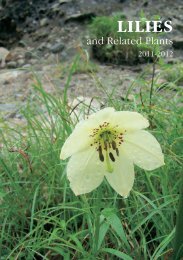LILIES - RHS Lily Group
LILIES - RHS Lily Group
LILIES - RHS Lily Group
You also want an ePaper? Increase the reach of your titles
YUMPU automatically turns print PDFs into web optimized ePapers that Google loves.
considered extinct but in 1984 the species was repeatedly discovered in several<br />
places of the Volgograd region, but in a limited area. This is a highly decorative<br />
bulbous plant with narrow leaves and an umbel of purple-pinkish flowers. The<br />
main bulb is surrounded by many bulbils. In July 1996 we discovered it on chalk<br />
hills of the Khoper River not far from the mouth of the Kumilga River (Firsov,<br />
Baranova, 1997). Clematis orientalis was another extremely interesting find, also<br />
from the chalk hills of the Khoper River, which we discovered quite recently, in<br />
August 2000. Here it grows hundred kilometres north from the main part of its<br />
natural habitat. This is the only arboreal climber in the flora of the whole Lower<br />
Don area, and the diminutive population near khutor (small Cossack village)<br />
Pustovsky, not far from the mouth of the Khoper River, represents the extreme<br />
northern point in the European part of its habitat (Firsov, 2002). Local bulbs and<br />
Liliaceous related plants are an important part of the native flora, they belong to<br />
the families Alliaceae, Colchicaceae, Hyacinthaceae, Iridaceae and Liliaceae.<br />
Vegetation<br />
The main type of vegetation of the steppe is grasses of different kind with<br />
a dominance of Festuca, some agriculture, water meadows, forests and<br />
chalk plants.<br />
The afforestation of the lower reaches of the Khoper River is about 12%,<br />
which is much more than at the average for the Volgograd region. The main<br />
woods are situated at the river valleys, these are so called ribbon forests. There<br />
are also upland and ravine forests which are of great importance for the local<br />
population and for the conservation of rare native species. The main forest tree is<br />
oak (Quercus robur) with poplars and elms (Populus nigra, Populus alba, Ulmus<br />
minor), Pyrus pyraster and Malus praecox. The white willow (Salix alba) forms<br />
forests along the river banks, together with other shrubby willows. Shrubby<br />
species, such as Amygdalus nana, Cerasus fruticosa, Prunus spinosa, produce<br />
thickets in steppe ravines and at the edge of upland and floodland forests.<br />
The water meadows of the Khoper River and its tributaries are species rich and<br />
some are used for hay making. The many species include Gentiana pneumonanthe,<br />
Fritillaria meleagroides, Gladiolus tenuis, Valeriana officinalis, Allium praescissum,<br />
with, among the dominant common meadow grasses, Alopecurus pratensis, Elytrigia<br />
repens and Poa pratensis. On lower ground around lakes one finds Iris pseudacorus,<br />
Symphytum tanaicense, Althaea officinalis and various sedges and dense thickets of<br />
Typha latifolia, Scirpus lacustris, Phragmites australis.<br />
As for really aquatic plants, there are about 15 species of Potamogeton, Trapa<br />
natans, or aquatic nut, Nymphaea alba and N. candida and the water fern,<br />
Salvinia natans, together with Lemna minor, Spirodela polyrhiza and other<br />
aquatic floating plants.<br />
108




